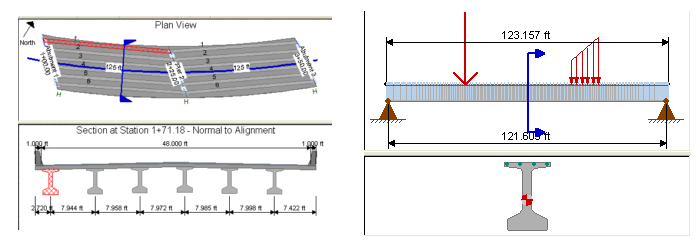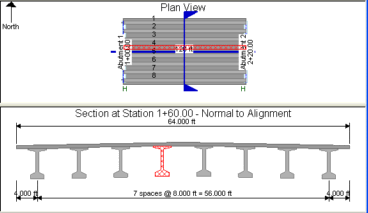|
TOGA
3.0
Texas Optional Girder Analysis
|
|
TOGA
3.0
Texas Optional Girder Analysis
|
It is important to understand that there are three different analytical girder models used for the TOGA analysis. They are as follows:
The TOGA program generates the second two models based on IGND/IBND information and other data made available to the TxDOT Fabrication Branch. Hence, simplifying assumptions, possibly many, are made in order to generate the models. It is very important that engineers understand these assumptions in order to determine if using TOGA is valid for their bridge design. The following sections describe each model in detail
This is the model used for the original bridge design used when creating design plan sheets. The Per-Plan model can contain a high level of detail based on the structure in question. The figure below shows an example of a very complex girder model in PGSuper (Girder 1, Span 1). It is likely that this girder should not be modeled using TOGA due to its complexity. However, this determination is left up to the bridge design engineer.

Once the Per-Plan Girder Model is designed, PGSuper can export its CAD Data which contains much of the IGND/IBND data. Plan sheets are then generated and the girder design can go on to the next step in the design process.
The only bridge input data that is not generated in the CAD Data export is the applied Uniform_Design_Load values. This is left up to the bridge design engineer. As you might imagine, it would be a challenge to determine equivalent uniform loads for the model shown in the figure above.
The following response data is taken directly from the Per-Plan Original Girder model and input into TOGA on the Bridge Input Tab. This data is referred to as Input Response Data.
Input Response data is used to calibrate and check the results from the Equivalent Original Girder Model as discussed in Optional Design Analysis
This simplified model is used by TOGA to mirror the analysis of the Per-Plan girder. For simple bridges, this model can exactly reflect all aspects of the Per-Plan model.
TOGA utilizes PGSuper to generate a simple model behind the scenes. Detailed information regarding the generated PGSuper model can be found here. The figure below shows a typical PGSuper model exported by TOGA:

As shown above, the Equivalent Original model is part of a PGSuper bridge model. Below is a list of salient analysis assumptions made during the generation and analysis of the equivalent PGSuper model.
Once the model is generated, PGSuper performs an analysis of the original girder to compute girder stresses and camber. Refer to PGSuper's Theoretical Manual for more information about analysis methods and assumptions.
The PGSuper girder analysis model for the Fabricator Optional Design coexists as an interior girder in the same bridge model with the Equivalent Original PGSuper girder model described in the previous section. In fact, the two girder models are identical except for prestressing strand data and concrete strength data. Hence, all modeling assumptions are the same for the two girders except for the computation of stresses. Details about stress factoring in the Fabricator Optional model are given here.